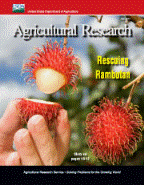United States Department of Agriculture: Agricultural Research Service, Lincoln, Nebraska

Agricultural Research Magazine
Date of this Version
2-2013
Document Type
Article
Citation
Agricultural Research February 2013.
Abstract
“We can obtain important results from short-term field studies, but they don’t always capture year-to year variability. Long-term research often provides more reliable results that farmers need,” says Agricultural Research Service horticulturist Eric Brennan.
Brennan speaks from personal experience. In 2003, he and a team of University of California-Davis collaborators began a 2-year field study that evolved into a unique long-term investigation of high value organic cropping. The project, the Salinas Organic Cropping Systems trial, is being conducted on an ARS research farm and is now in its 10th year of certified organic production. Brennan, who works in the ARS Crop Improvement and Protection Research Unit in Salinas, California, is analyzing a huge collection of data to pinpoint findings that can benefit commercial producers of organic crops.
Production expenses for high-value organic crops like lettuce and broccoli can exceed $7,000 per acre. Producers who pay high land rent need to maximize profits with an annual two- to three-crop rotation that also includes either keeping fields fallow in the winter or planting winter cover crops. Many farmers keep winter fields bare because of the extra work and expense of tilling cover crop residues into the soil. Planting a cover crop also requires allowing enough time for its residue to decompose before planting cash crops—and production schedules can become very tight if prolonged spring rains keep farmers from plowing under the winter cover crops.
Brennan designed a long-term investigation of several different cover cropping strategies for an annual lettuce-broccoli production system. Six of the strategies involved cover cropping every winter, and the other two involved cover cropping every fourth winter.
Brennan selected three winter cover crops often grown in the area—rye, mustard, and a legume-rye mix—and planted each at either a typical seeding rate or a rate three times higher. Seeding rates can affect a cover crop’s ability to smother weeds.
All systems received the same fertilizer and irrigation inputs and pest management. Harvest and sale of the lettuce and broccoli crops—which met all U.S. Department of Agriculture organic standards—were conducted by a commercial harvester.
Included in
Agriculture Commons, Animal Sciences Commons, Food Science Commons, Plant Sciences Commons

